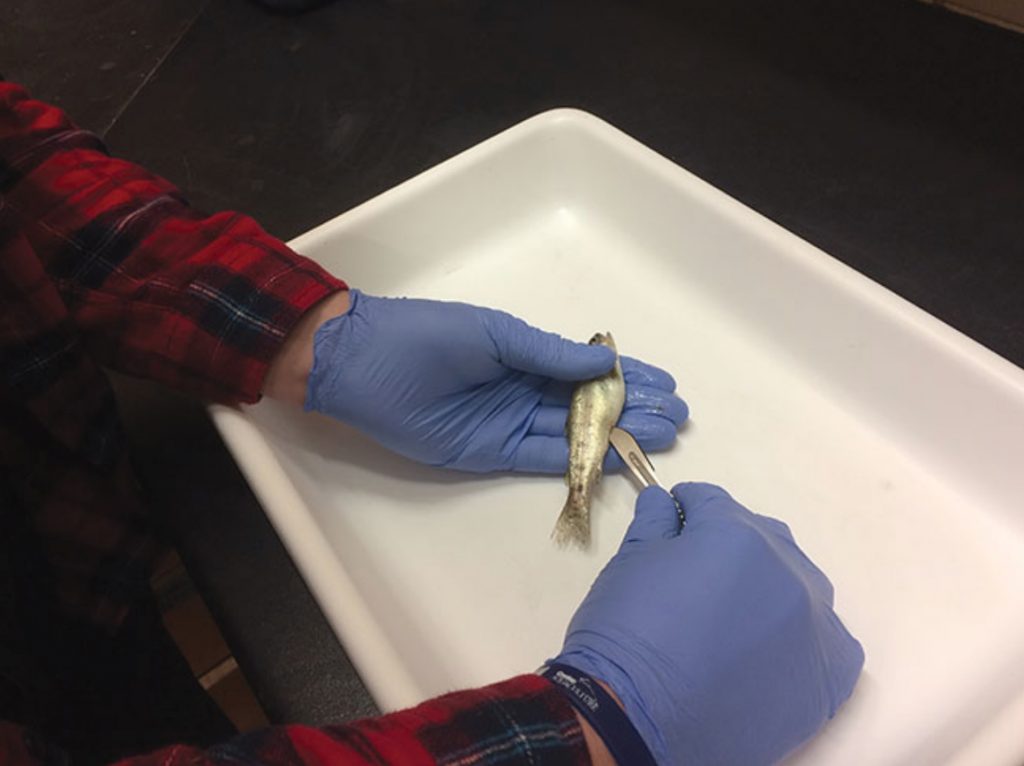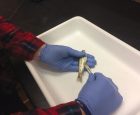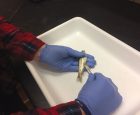
Features
Research
Managing morts
Inspection and classification of mortalities found in a system is an essential tool for hatchery management. It is not enough just to collect mortalities in a timely manner and manage based on the number of total dead fish.
February 1, 2019 By Ron Hill
 Performing internal examinations of morts can provide valuable insights on the health of the fish in the hatchery.
Performing internal examinations of morts can provide valuable insights on the health of the fish in the hatchery. The raw number of mortalities in a tank or across a facility does little to help with analysis and diagnosis of larger issues and tells the hatchery manager very little. The dead fish themselves hold much info if they are analyzed quickly.
Mykolas Kamaitis, veterinarian for Marine Harvest Canada explains: “Daily removal and classification of morts is not only important for limiting the potential spread of pathogens and infectious agents; timely removal also gives farm staff the opportunity to classify the mortalities by cause of death and to pick up on early signs of fish health concerns. Fry/fingerlings can decompose very quickly, so the sooner they can be assessed, the better chance you’ll be able to get some useful information out of them.”
Each mortality in the system should be classified into predetermined categories as best as possible. Categories used will match the specific needs of the facility. Common categories include: deformities, fungus, human error, handling, post transport losses, jumpers, lethal sampling, and eye pecking. There are many other site-specific categories.
Beware of allowing broad categories like “disease” to be used in day to day farm mortality collection. Diseased deaths should only be coded as such after diagnosis by a vet and should be coded to that disease. Always add a category for the unexplainable mortality and for decayed fish. “Non codable” is a popular category for those fish that have decayed too far for any classification. “Fresh mort” is a good category to use with fish that look fine when examined externally but are collected mortalities.
Identifying trends
Trends found in categories lend evidence to the issues affecting groups of fish. This can be seen at the tank, system and farm levels and will give indications of where a particular mortality originates. Fungus morts may rise in a particular system but not in the others, indicating something may be wrong with the filtration/disinfection of the affected system.
Long term analysis of morts can also show the farmer how most of the fish are being lost and at what life stage. If there are extremely high numbers of deformities, there may be an issue with the source of fish. Large losses to eye pecking may indicate problematic under feeding at the farm. Along with investigation of the large and historical data, mortality classification data is extremely useful to help determine underlying root issues in a fish rearing system and leads to improved operations.
Internal exams
It is also important to do internal examinations of mortalities. “Cutting open morts (when they are large enough to effectively do so) is also very valuable for monitoring the health of your fish,” Kamaitis says. “What you see on the outside of a fish is only part of the picture. Routinely cutting open morts to assess internal organs, including internal fat content, and whether fish are on feed, can alert you to possible environmental and water quality concerns, developmental issues (e.g. deformities) or presence of disease in a population of fish.”
These signs in your fish, particularly the absence of feed, give the farmer ideas on where to look for issues in the system such as water quality or filtration failure, and give an assessment of the population as a whole.
Examining the fat content of the fish, particularly the pyloric caeca of salmonids, may provide an indication of how well the fish has been feeding and the availability of feed to that fish. A healthy, well-fed fish will have fat throughout and all around the caeca.
Check the gills
Examine the gills of every fish collected. The shade of the gills will indicate how long the fish has been deceased. A fish with bright, red gills has just recently died. Upon death, the gills quickly start to pale then fade to grey. Look for mucus on the gills that may indicate gill irritation and inflammation.
A well thought-out system for mortality classification and analysis can provide the farmer a valuable information resource. It’s important to make sure to train all new workers in the classification system so that everyone knows exactly what signs to look for when diagnosing morts, to maintain consistency in the data.
Print this page
Advertisement
- New leader at Institute of Aquaculture
- InnovaSea takes over RAS-focused company Water Management Technologies








